72 Articles
Tags :vaping Page 4

Cov Khoom Siv Pov Tseg. Ntxiv: To taub txog ib puag ncig kev cuam tshuam rau lub ntiaj teb ntawm vaping tau hloov kho tas li, Qhia cov neeg siv nrog myriad ntawm kev xaiv. Ntawm cov no, cov kev sib cav ntawm cov khoom siv pov tseg thiab rov ua tau vaping tau tshwm sim, Tshwj xeeb hais txog lawv qhov kev cuam tshuam ib puag ncig. Raws li kev txhawj xeeb thoob ntiaj teb rau kev ua kom muaj sia nyob, Ntau cov neeg siv vape pom lawv tus kheej nug: txoj kev twg yog qhov zoo dua rau cov ntiaj chaw? Tsab ntawv no rho mus rau ib puag ncig hneev ntawm ob txoj kev uas nrov. Cov Khoom Siv Uas Siv Tau Siv: Kev yooj yim ntawm cov nqi pov tseg cov nqi yog tsim los rau siv sijhawm ib zaug, Muab qhov yooj yim ntawm kev siv uas tshwj xeeb tshaj plaws nyiam cov neeg siv tshiab. Txawm yog, their convenience comes with significant drawbacks. Each unit contributes to environmental waste as they are typically made from plastic and metal, elements that...

Taw qhia hauv Xyoo Tsis ntev, cov vaping toj roob hauv pes tau hloov zuj zus, tshwj xeeb nrog cov lus qhia ntawm cov khoom siv Nicotine zoo li TFN (Kev haus luam yeeb-pub dawb). Raws li cov neeg tau txais kev pab ntxiv tshawb xyuas cov kev xaiv rau Nicotine Tsiv, nws tiav niam txiv heev kom nkag siab li cas cov kev hloov tshiab no cuam tshuam cov kev kawm vaping. Tsab ntawv no rho mus rau hauv qhov sib txawv ntawm TFN thiab Nicotine tsoosine, hais txog txoj kev xaiv hluavtaws hluav taws xob tuaj yeem txhim kho lossis hloov koj cov kev vaping. Cov hauv paus: Dab Tsi TFN? Tfn, lossis haus luam yeeb-pub dawb nicotine, yog cov khoom tsim tawm ntawm nicotine uas tsis tau txais los ntawm cov kws luam yeeb tsob ntoo. Fab ntxeev, Nws yog tsim hauv chav kuaj, Tso cai rau lub purer, Muaj peev xwm ntau cov khoom ruaj khov. Qhov tseem ceeb no cov yam ntxwv tau teeb tsa TFN sib nrug los ntawm cov nicotine ib txwm muaj, uas yog rho tawm los ntawm cov nplooj luam yeeb. Ntau ...
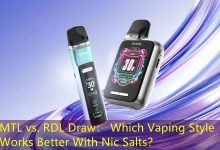
MTL vs. RDL kos: Uas vaping style ua haujlwm zoo dua nrog cov ntsev zoo nkauj? Thaum nws los vaping, ntau tus neeg txhawb nqa feem ntau pom lawv tus kheej nraus ntawm ** mtl (Qhov ncauj-rau-ntsws)** thiab ** RDL (Txwv tsis pub ncaj ntsws)** yeej. Txhua txoj kev muaj nws cov yam ntxwv tshwj xeeb uas tuaj yeem cuam tshuam ntau txoj kev vaping kev paub, Tshwj xeeb tshaj yog thaum siv nrog ** Nicotine Salts **. Kab lus no aim los tshawb nrhiav qhov sib txawv ntawm MTL thiab RDL kos thiab txiav txim siab seb hom twg haum rau Nicotine Salts. Nkag siab MTL thiab RDL Sau MTL Vaping Mimics Lub Tsev Kawm Ntawv Qub Tsev Kawm Ntawv ntawm Haus Luam Yeeb, qhov twg koj kos lub vapor rau hauv koj lub qhov ncauj ua ntej nqus tau rau hauv koj lub ntsws. Hom no yog nyiam los ntawm ntau cov neeg haus luam yeeb vim tias nws tso cai rau kev ua kom txaus siab heev. Sib tham, RDL Vaping ...
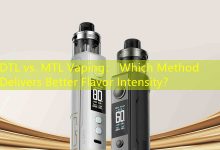
DTL vs. MTL Vaping: Which Method Delivers Better Flavor Intensity? The debate surrounding Direct-to-Lung (DTL) Thiab qhov ncauj-rau-ntsws (Mtl) vaping has been a focal point for both novice and experienced vapers. Each method presents distinct advantages and appeals to varying preferences when it comes to flavor intensity, caj pas ntaus, thiab tag nrho kev. Hauv tsab xov xwm no, we will delve into product specifications, design characteristics, performance assessments, and user demographics for both vaping techniques. Product Overview and Specifications DTL and MTL vaping require different devices with unique specifications tailored to enhance their respective experiences. For DTL vaping, devices such as sub-ohm tanks and cloud-capable mods have larger airflow systems, enabling users to inhale vapor directly into their lungs. These devices typically feature lower...

1. Taw qhia txog Wattage Txwv nyob rau hauv Vaping Vaping tau dhau los ua kev hloov tshiab los ntawm kev haus luam yeeb ib txwm, Muab ntau cov flavors thiab kev xaiv rau ob qho kev paub cov neeg siv thiab cov neeg tuaj tshiab zoo ib yam. Ib qho tseem ceeb ntawm cov vaping uas cov pib tshiab yuav tsum nkag siab yog lub tswvyim ntawm wattage txwv. Wattage tsis yog cuam tshuam rau kev ua tau zoo ntawm koj lub cuab yeej tab sis kuj ua lub luag haujlwm tseem ceeb hauv kev txiav txim siab tag nrho cov kev ua tiav. Nkag siab txog kev txwv Wattage tuaj yeem pab koj ua kom zoo koj cov khoom siv ntaus ntawv rau qhov tsw zoo, vapor ntau lawm, thiab caj pas ntaus. 2. Dab tsi yog wattage hauv vaping? Wattage hais txog tus nqi ntawm kev siv zog siv hauv cov vaping ntaus ntawv, Tshwj xeeb nyob rau hauv yuav ua li cas nws ua kom sov sov lub kauj los ua cov vapor. Cov neeg tsim khoom feem ntau qhia kom meej lub wattage..

Taw qhia rau roj teeb li roj hauv E-luam yeeb hauv lub ntiaj teb ntawm Vaping, Qhov zoo ntawm lub roj teeb yog qhov tseem ceeb rau kev ua kom zoo dua. Lub sijhawm ntev ntawm lub roj teeb tuaj yeem cuam tshuam kev ua tau zoo, cov neeg siv kev txaus siab, thiab tag nrho vaping kev paub. Ntau yam pab txhawb rau qhov sib txawv hauv cov roj teeb nqa, uas peb yuav tshawb txog hauv kev nthuav dav. Pws Me Peqauj | Ib qho ntawm thawj kev txiav txim siab ntawm kev ua haujlwm roj teeb yog nws cov tshuaj. Feem ntau hom roj teeb siv tau siv hauv cov luam yeeb hauv hluav taws xob yog lithium-ion (Li-ion) thiab lithium polymer (Laspo). Lithium-ion roj teeb li-ion roj teeb tau paub rau lawv lub zog siab ntom thiab hluav taws xob hluav taws xob tawm. Lawv zoo li muaj lub neej ntev dua, Lub ntsiab lus lawv tuaj yeem ua kom them nyiaj ntxiv thiab tawm mus ncig ua ntej lawv lub peev xwm ploj zuj zus. Lithium polymer roj teeb.
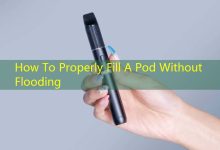
Introduction to Filling a Pod Correctly The electronic cigarette market has evolved significantly over the years, with an increasing number of users shifting from traditional smoking to vaping. One of the critical elements in ensuring an enjoyable vaping experience lies in the proper filling of pods. This guide focuses on the best practices for filling a pod without flooding, particularly in the context of the latest e-cigarette models introduced in 2025. Product Overview and Specifications Modern pod systems are designed for ease of use, kev yooj yim, and portability. These devices typically consist of two main components: the pod and the device’s battery unit. The pods usually hold a e-liquid capacity ranging from 2ml to 5ml, depending on the manufacturer and model....
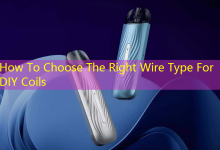
1. Taw qhia rau DIY Coils hauv ntiaj teb ntawm Vaping, Cov qauv ntawm DIY (Ua koj tus kheej) Coils tau ntes cov paj los ntawm ntau tus neeg nyiam. Tsim koj tus kheej coils tsis tsuas yog tso cai rau kev customization nyob rau hauv cov tsw thiab vapor ntau lawm tab sis kuj muab cov neeg siv kev nkag siab tob ntawm lawv cov khoom siv vaping. Ib qho tseem ceeb tshaj plaws ntawm kev tsim cov coils zoo yog xaiv cov xaim xaim xaim. Kab lus no yuav coj koj los ntawm cov hlau sib txawv muaj rau DIY coils thiab yuav ua li cas xaiv qhov zoo tshaj plaws ib qho rau koj cov kev xav tau. 2. Nkag siab txog kev tiv taus thiab OHM txoj cai ua ntej peb delve mus rau hauv ntau hom hlau hom, Nws yog qhov tseem ceeb kom nkag siab txog qee cov ntsiab lus tseem ceeb xws li OHM txoj cai. Kuj Ua Ib ...

Yuav ua li cas kom huv cov lus qhia rau kev tu cov vaping vaping tau dhau los ua kev haus luam yeeb ib txwm muaj, Muab ntau cov flavors thiab tsis tshua muaj kev nyuaj siab. Txawm yog, Ib yam li lwm yam khoom haus luam yeeb, Cov Lus Qhia Cov Lus Qhia tuaj yeem khaws cov av nkaus xwb, nyob, thiab cov kab mob dhau sijhawm. Tsim nyog txij nkawm yog tsis yog qhov tseem ceeb rau saj tab sis kuj ua lub luag haujlwm tseem ceeb hauv koj txoj kev noj qab haus huv tag nrho. Hauv tsab xov xwm no, Peb yuav tham txog yuav ua li cas cov lus qhia kev ua kom huv si kom ntseeg tau kev paub tab. Nkag Siab Cov Lus Qhia Hloov thiab lawv cov lus qhia yooj yim yog lub qhov ncauj ntawm cov khoom siv vaping uas tso cai rau cov neeg siv nqus pa. Lawv tuaj nyob rau ntau cov ntaub ntawv, suav nrog yas, hlau, Thiab iav, txhua tus nrog nws tus kheej zoo thiab qhov tsis zoo. Tu C ...
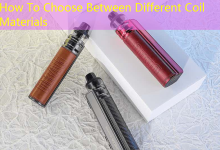
1. Understanding Coil Materials in Vaping Coil materials play a pivotal role in the performance of an electronic cigarette, affecting everything from flavor and vapor production to the lifespan of the coil itself. With various materials available on the market, selecting the right coil can significantly enhance your vaping experience. As vapers become more knowledgeable about their devices, understanding the different types of coil materials is crucial for optimizing vape quality and personal preferences. 2. Common Coil Materials There are several popular coil materials used in vaping, txhua tus nrog nws cov yam ntxwv tshwj xeeb. Feem ntau yog KANTHAL, Stainless hlau, tus menyuam yaus, thiab titanium. KANTHAL yog cov hlau ua hauj hlau ua feem ntau ntawm cov hlau, yeebsab, Thiab Txhuas. Nws yog paub txog nws txoj kev ua siab ntev.









